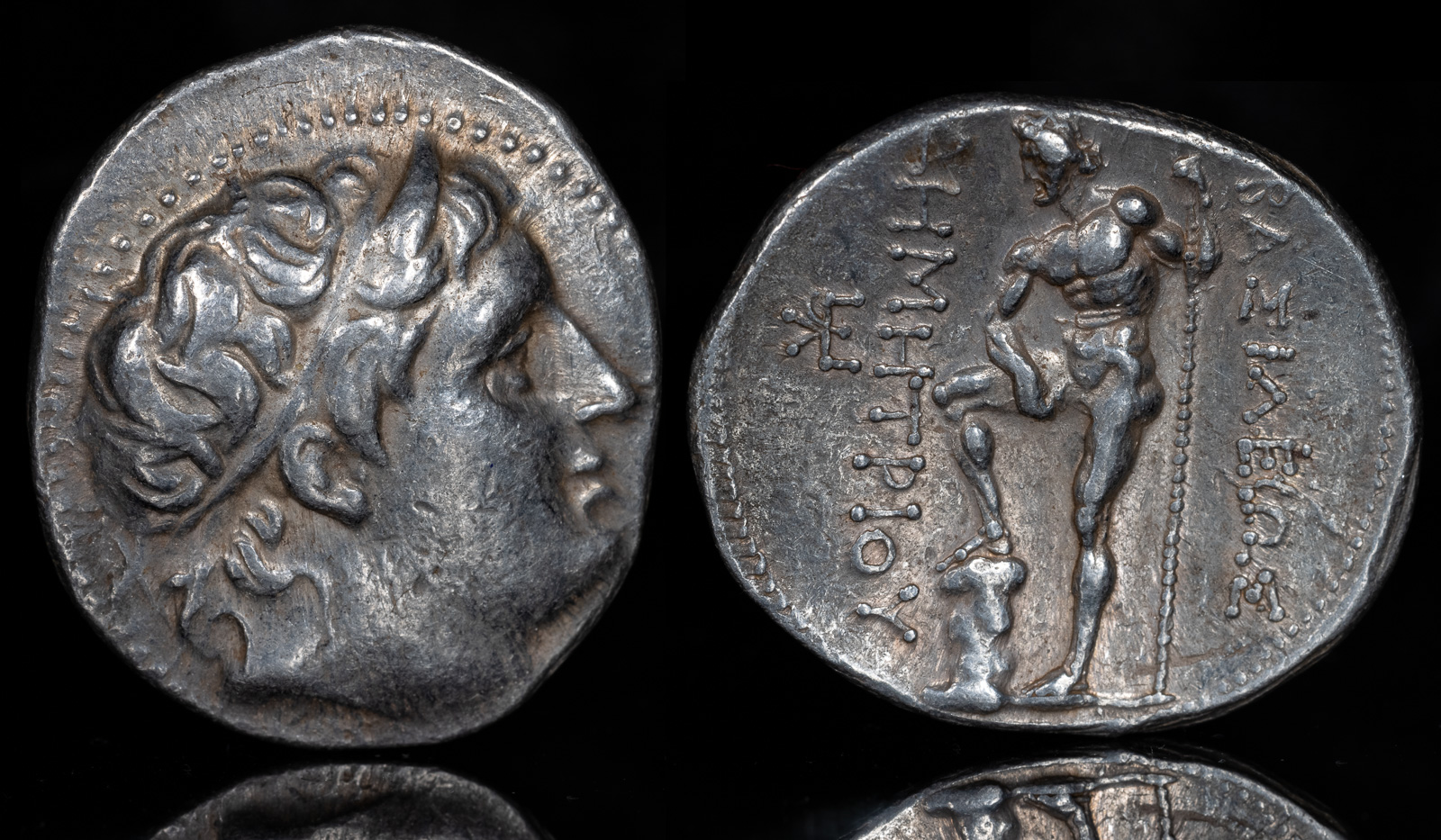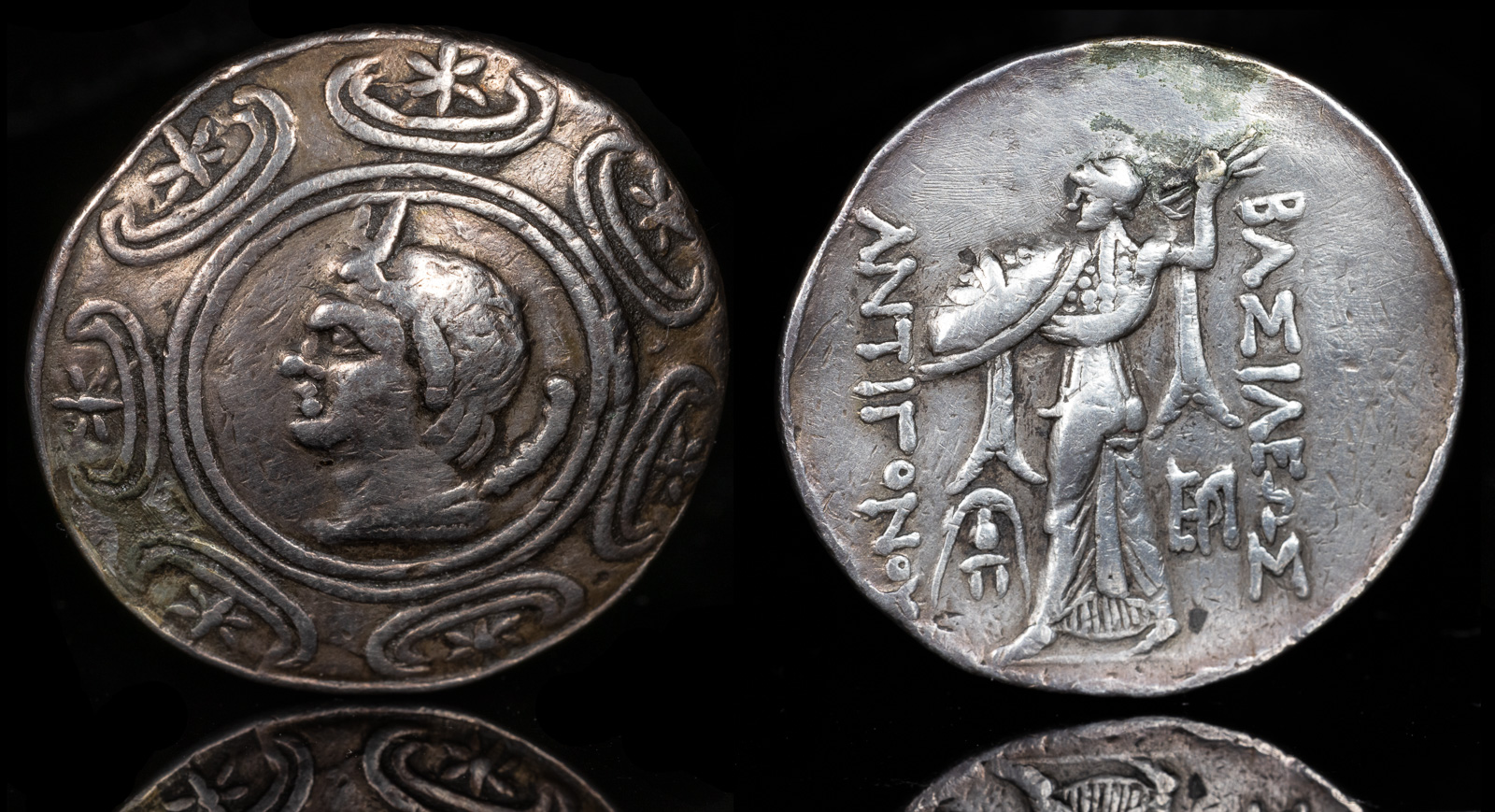
Antigonos I Monophthalmos
Antigoneia 305-300 BCE
29mm 16.33g
Head of young Herakles facing right, wearing a lion’s skin. / ALEXANDPOY, Zeus enthroned left, holding an eagle and a sceptre, X on left, M on right, Ph below throne.
Price 3195, Müller 804
The Antigonid dynasty is named after Antigonos I Monophthalmos, who was a general under Alexander the Great. Together with his son, Demetrios I Poliorketes, he grew to be a major thorn in the side of the rest of the diadochi and became so powerful that it required a concerted effort from all of them to take him down.

Kings of Macedon. Pella. Demetrios I Poliorketes 306-283 BC.
Tetradrachm AR 30 mm, 17,12 g
Diademed and horned head of young Demetrios right / ΒΑΣΙΛΕΩΣ ΔΗΜΗΤΡΙΟΥ, poseidon standing left resting foot on rock, monograms at either side.
Newell 90
After their defeat and Antigonos’ death in the Battle of Ipsos in 301 BCE, Demetrios headed the monarchy. He eventually took control of Macedon, but not long after he was taken prisoner by Seleukos I Nikator.
It was Demetrios’ son Antigonos II Gonatas who eventually provided some normalcy to the line. He eventually took control of Macedon and passed it on to his son, Demetrios II.

Kings of Macedon, Antigonos II Gonatas (277/6-239 BCE)
Amphipolis, c. 274/1-260/55 BCE
AR Tetradrachm 31mm, 16.85g, 3h
Horned head of Pan l., lagobolon over shoulder, in the centre of a Macedonian shield
R/ Athena Alkidemos advancing l., preparing to cast thunderbolt; crested Macedonian helmet to inner l., monogram to inner r.
HGC 3, 1042; Panagopoulou 2000 Period I, Group I, #7 (O3, R07) (this coin)
Ex L. de Nicola, Rome Sep 1974
It then went to Antigonos III Doson, Philip V, and finally Perseus before the Antigonid line ended with the crushing of Macedon by Rome.
Antigonos declares himself king, thus beginning the Antigonid dynasty.
The Battle of Ipsos. Demetrios Poliorketes and Antigonos Monophthalmos are defeated by Seleukos I Nikator, Kassander (commanded by Pleistarchos), and Lysimachos. Antigonos is killed. Demetrios continues the Antigonid dynasty.
Demetrios Poliorketes dies while imprisoned by Seleukos I Nikator. Antigonos II Gonatas continues the Antigonid dynasty.
Antigonos II dies. Demetrios II becomes king of Macedon and continues the Antigonid dynasty.
Death of Demetrios II of Macedon. Antigonos III Doson continues the Antigonid dynasty.
Tegea is taken by Antigonos II Doson and annexed to the Achaian League.
Death of Antigonos III Doson. Philip V continues the Antigonid dynasty.
Ambrakia is besieged by Philip V of Macedon, Phytia taken, and Metropolis is burned during the Social War between the Achaean League and the Aetolian League, of which Ambrakia is a member.
Psophis is taken by Philip V.
Philip V attempts to take Pale, but finds it too difficult and leaves.
Philip V attempts to push Stratos to fight against him, but is unsuccessful.
Philip V attempts to take Melitaia but fails because his scaling-ladders are too short.
Philip V takes Thebai, renames it to Philipoppolis, and enslaves the inhabitants.
A Roman army under Sulpicius Puplius and the Aetolian League ravages Sikyon before being pushed out by Philip V.
Kios and Myrleia destroyed by Philip V, which enrages the Aetolian League.
Philip V persuades Kalchedon and Lysimachia to break from the Aetolian League.
Philip V tricks Thasos into subjugation, promising to not install a garrison and then enslaving the entire city.
Philip V takes Alabanda.
Troops the Athamanes and the Aetolian League camp near Pharkadon, but are attacked by troops of Philip V and pushed away.
Philip V destroys Skiathos.
Philip V destroys Phakion.
After the Battle of Cynoscephalae, the treaty between the Romans and Philip V is signed at Larissa.
Philip V is defeated by Titus Quinctius Flamininus at the Battle of Skotussa.
Death of Philip V, King of Macedon. Perseus continues the Antigonid dynasty.
Stratos makes an alliance with the Romans against Perseus of Macedon.
June 22
June 22
July
Philip of Macedon, after being defeated at the Battle of Pydna, stops briefly at Galepsos before heading to Samothrace.